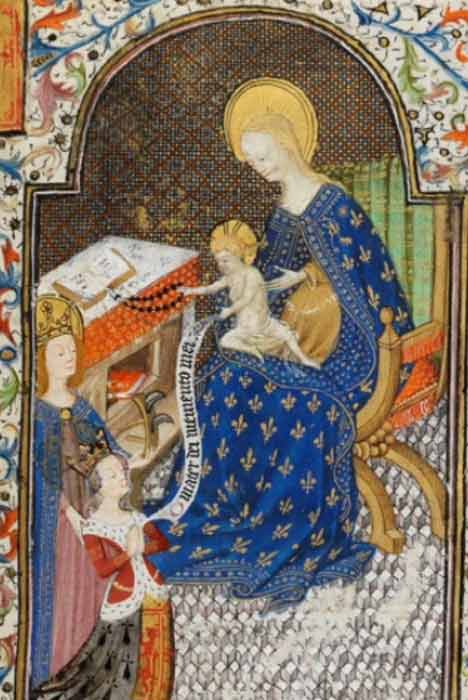Some good old-fashioned swinging? Medieval photoshopping? Not quite, but scientists have discovered something about Francis I of Brittany that he would surely have preferred to have kept secret. Researchers and scientists at Cambridge’s historic Fitzwilliam Museum , part of the team curating “The Human Touch” exhibition, noticed something was amiss when they were examining the Christian medieval bestseller, “ The Hours of Isabella Stuart .” What they noticed was that one of the paintings was “altered” and that the owner had pulled off a wife swap, replacing the first wife with the second. This was a religious book, so a wife swap was, in more ways than one, a fairly controversial revision.
‘The Hours of Isabella Stuart ’ written in Latin, was produced for Yolande of Aragon, and completed in the year 1431 AD, beautifully painted on vellum (goat or cow skin), with gold, ink and egg tempera. According to The Evening Standard , “it is based on the monastic day for use in daily life.”
An article in The Art Newspaper states that the manuscript’s original pigments were analyzed through infrared photographic technology, revealing that Francis I of Brittany’s first wife, Yolande of Anjou (daughter of Yolande of Aragon), was replaced both in print in the prayer book and in real life, with his second wife. And this so-called wife swap has both intrigued researchers and amazed modern readers.

The page from the manuscript, showing the Virgin and Child, St Catherine (far left) and Isabella Stuart (in red coat), the new bride. ( Cambridge University Press )
A Medieval Wife Swap Exposed With Modern Infrared Technology
Co-curator Dr Suzanne Reynolds said, “something was ‘amiss’ and a ‘darker area’ was noticed on a page ‘so it was decided to use infrared and see what was going on there.”
“That’s when the under-drawing was revealed,” Dr Reynolds was quoted by the Daily Mail . “What they also did was add in the coat of arms of the second wife into the borders around the manuscript.”
In the “original” Yolande appeared as a tiny figure kneeling before the Virgin Mary on a glorious, well-illustrated page. To pull off the wife swap, Yolande’s face was painted over with that of Isabella’s, the second wife. In addition to this alteration, “ ermine trimmed heraldic robes ,” and the figure of St. Catherine was added in the background.

Isabella’s ducal coronet, and figure of St Catherine from a page from the Book of Hours showing how the red in the new image was different from the reds used in the original images, thus revealing the wife swap. (Katie Young / Fitzwilliam Museum )
To make the wife swap look really authentic, Isabella’s coat of arms was added to the floral design borders of that page. The same vermilion hue of red was employed on her gown, which differed from the deep red used in the original, as revealed by the infrared scans.
Though Isabella was adorned with Yolande’s headdress, in the wife swap version that too was painted over to give her a golden crown with many jewels. This was synonymous with Francis’s succession from count to duke, after the death of his father in 1442 AD.
The manuscript was altered again to accommodate the first daughter of their marriage, Margaret, in the form of an extra page, and an ode to the Virgin Mary in terms of kneeling and prostrating before her in prayer.

Painting of Francis I of Brittany by an unknown artist. As the Duke of Brittany, he had his first wife painted over in the book first commissioned by her, replacing “her” with details relating to his second wife. ( Public domain )
The “The Hours of Isabella Stuart” and the Fitzwilliam Museum
Francis I, Count of Montfort l’Amaury, was the Duke of Brittany from August 1442 to 1450, when he died. His mother, Joan of France was the daughter of King Charles VI of France and his father, John V, was the previous Duke of Brittany.
He was married to Yolande of Anjou in Nantes in 1431, with whom he had a son. Both wife and son tragically died within the next decade, following which he married Isabel of Scotland in 1442, with whom he had two children.
“The Hours of Isabella Stuart ” is so historically significant because of its commissioning and appropriation by the wealthy, in this case, the mother of the first wife of Duke Francis I of Brittany, who was a patron of arts and culture. It was intended as a wedding gift for Yolande, who tragically died in the year 1440. It was widely recognized as one of the most beautiful and extensively decorated illustrated medieval works, renowned for its strong Christian overtones, and its 500 jewel-like miniature paintings .
“These books in a way are sort of archaeological sites and when you start to uncover what lies under these images it actually unlocks the human story of how these books were commissioned and then passed from one person to another as the story of these different marriages and different dynastic alliances evolved,” said Dr. Reynolds.
Anglo-Irish nobleman, Richard Fitzwilliam of Dublin, after whom the Cambridge museum is named, became the owner of this book till it was passed onto the museum after his death in 1816.
The museum’s “ Human Touch ” exhibition opens to the public on May 18th and will run until August 2021. And visitors can expect to see the amazing medieval wife swap manuscript in all it’s glory during this period.
Top image: A page from “The Hours of Isabella Stuart,” an ancient medieval manuscript in which researchers noticed the wife swap in the image on one of the book’s pages. Source: Katie Young / Fitzwilliam Museum
By Rudra Bhushan
Related posts:
Views: 0
 RSS Feed
RSS Feed

















 May 19th, 2021
May 19th, 2021  Awake Goy
Awake Goy  Posted in
Posted in  Tags:
Tags: 
















